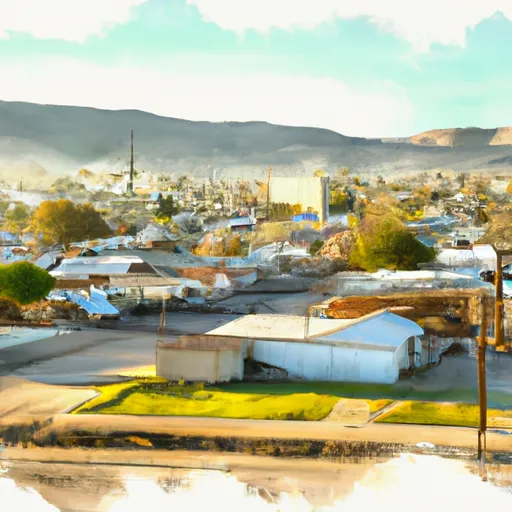-
 Snoflo Premium
Snoflo Premium
Get unlimited access to all our content
With no Ad interruptions! - Start Your Free Trial Login with existing account
Shoshone
Eden Index
Climate
8.0
•
Recreation
2.8
•
Community
2.4
•
Safeguard
4.8/10

Shoshone, California is a small unincorporated community located in Inyo County. Situated in the southeastern part of the state, Shoshone enjoys a desert climate with hot summers and mild winters. Summers can see temperatures soaring above 100°F (38°C), while winters are relatively mild, with temperatures typically ranging between 40°F (4°C) and 60°F (16°C).
Hydrologically, Shoshone is notable for its proximity to the Amargosa River. This river contributes to the area's unique ecosystem and supports diverse plant and animal life. Springs and seeps along the river also attract a variety of bird species, making it a haven for birdwatching enthusiasts.
Outdoor recreation opportunities in Shoshone abound. The nearby Death Valley National Park offers visitors a chance to explore stunning landscapes, including sand dunes, canyons, and salt flats. Popular activities include hiking, camping, and wildlife viewing. Additionally, the nearby Dumont Dunes Off-Highway Vehicle Recreation Area provides thrill-seekers with opportunities for off-road adventures.
In summary, Shoshone, California offers a desert climate, showcasing hot summers and mild winters. Its proximity to the Amargosa River provides hydrological diversity, while outdoor enthusiasts can enjoy a range of activities in the nearby Death Valley National Park and Dumont Dunes Off-Highway Vehicle Recreation Area.
What is the Eden Index?
The Snoflo Eden Index serves as a comprehensive rating system for regions, evaluating their desirability through a holistic assessment of climate health, outdoor recreation opportunities, and natural disaster risk, acknowledging the profound impact of these factors on livability and well-being.
Climate Health Indicator (CHI): 8.0
Shoshone receives approximately
144mm of rain per year,
with humidity levels near 36%
and air temperatures averaging around
20°C.
Shoshone has a plant hardyness factor of
8, meaning
plants and agriculture in this region tend to thrive here all year round.
By considering the ideal temperature range, reliable water supplies, clean air, and stable seasonal rain or snowpacks, the Climate Health Indicator (CHI) underscores the significance of a healthy climate as the foundation for quality living.
A healthy climate is paramount for ensuring a high quality of life and livability in a region, fostering both physical well-being and environmental harmony. This can be characterized by ideal temperatures, reliable access to water supplies, clean air, and consistent seasonal rain or snowpacks.
Weather Forecast
Streamflow Conditions
Northern Mojave
Area Rivers
Northern Mojave
Snowpack Depths
Northern Mojave
Reservoir Storage Capacity
Northern Mojave
Groundwater Levels
Recreational Opportunity Index (ROI): 2.8
The Recreational Opportunity Index (ROI) recognizes the value of outdoor recreational options, such as parks, hiking trails, camping sites, and fishing spots, while acknowledging that climate plays a pivotal role in ensuring the comfort and consistency of these experiences.
Access to outdoor recreational opportunities, encompassing activities such as parks, hiking, camping, and fishing, is crucial for overall well-being, and the climate plays a pivotal role in enabling and enhancing these experiences, ensuring that individuals can engage in nature-based activities comfortably and consistently.
Camping Areas
| Campground | Campsites | Reservations | Toilets | Showers | Elevation |
|---|---|---|---|---|---|
| Tecopa Hot Springs Park | 250 | 1,390 ft | |||
| Shoshone Dispersed - Tecopa | None | 1,691 ft |
Catastrophe Safeguard Index (CSI):
The Catastrophe Safeguard Index (CSI) recognizes that natural disaster risk, encompassing floods, fires, hurricanes, and tornadoes, can drastically affect safety and the overall appeal of an area.
The level of natural disaster risk in a region significantly affects safety and the overall livability, with climate change amplifying these risks by potentially increasing the frequency and intensity of events like floods, fires, hurricanes, and tornadoes, thereby posing substantial challenges to community resilience and well-being.
Community Resilience Indicator (CRI): 2.4
The Community Resilience Indicator (CRI) recognizes that education, healthcare, and socioeconomics are crucial to the well-being of a region. The CRI acknowledges the profound impact of these elements on residents' overall quality of life. By evaluating educational resources, healthcare accessibility, and economic inclusivity, the index captures the essential aspects that contribute to a thriving community, fostering resident satisfaction, equity, and social cohesion.

